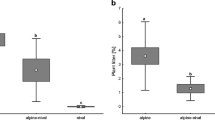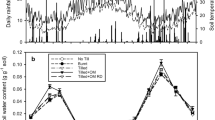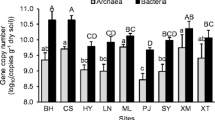Abstract
Purpose
Boreal peat soils comprise about 3% of the terrestrial environments, and when drained, they become sources of the greenhouse gas nitrous oxide (N2O). Ammonia oxidation can result in N2O emissions, either directly or by fuelling denitrification, but we know little about the ecology of ammonia-oxidizing bacteria (AOB) and archaea (AOA) in peat soils. Our aim was to determine temporal alterations in abundance and composition of these communities in a drained and forested peat soil in relation to N2O emissions and ammonia oxidation activity.
Materials and methods
The peat was sampled at three different depths in the upper 0.5 m over a period of 9 months covering two summer and two winter samplings. Community composition and abundance were determined by T-RFLP and quantitative real-time PCR of the bacterial and archaeal amoA genes. Potential ammonia oxidation rates were measured using the chlorate inhibition technique, and in situ N2O emission was determined using chambers.
Results and discussion
The soil parameters displayed little spatial and temporal heterogeneity, which probably explained why there were no depth-related effects on the abundance, composition, or activity of the ammonia oxidizers. In contrast to most terrestrial environments, the AOB dominated numerically over the AOA. Both groups changed in community composition between sampling occasions, although the AOB showed more significant seasonal signatures than the AOA. Temporal changes in abundance were only observed for the AOB, with a decrease in numbers from May to March. Such differences were not reflected by the activity or N2O emissions.
Conclusions
The high ammonium concentrations in the peat soil likely favored the AOB over the AOA, and we hypothesize that they were more active than the AOA and therefore responded to climatic and environmental changes. However, other processes rather than ammonia oxidation were likely responsible for N2O emissions at the site.




Similar content being viewed by others
References
Anderson MJ (2001) A new method for non-parametric multivariate analysis of variance. Austral Ecol 26:32–46
Bardgett RD, Lovell RD, Hobbs PJ, Jarvis SC (1999) Seasonal changes in soil microbial communities along a fertility gradient of temperate grasslands. Soil Biol Biochem 31:1021–1030
Belser LW, Mays EL (1980) Specific inhibition of nitrite oxidation by chlorate and its use in assessing nitrification in soils and sediments. Appl Environ Microbiol 39:505–510
Berg P, Rosswall T (1985) Ammonium oxidizer numbers, potential and actual oxidation rates in two Swedish arable soils. Biol Fertil Soils 1:131–140
Berg P, Rosswall T (1987) Seasonal variations in abundance and activity of nitrifiers in four arable cropping systems. Microb Ecol 13:75–87
Bohrerova Z, Stralkova R, Podesvova J, Bohrer G, Pokorny E (2004) The relationship between redox potential and nitrification under different sequences of crop rotations. Soil Till Res 77:25–33
Boyle-Yarwood SA, Bottomley PJ, Myrold DD (2008) Community composition of ammonia-oxidizing bacteria and archaea in soils under stands of red alder and Douglas fir in Oregon. Environ Microbiol 10:2956–2965
Bremner JM, Breitenbeck GA, Blackmer AM (1981) Effect of anhydrous ammonia fertilization on emission of nitrous oxide from soils. J Environ Qual 10:77–80
Caffrey JM, Bano N, Kalanetra K, Hollibaugh JT (2007) Ammonia oxidation and ammonia-oxidizing bacteria and archaea from estuaries with differing histories of hypoxia. ISME J 1:660–662
Di HJ, Cameron KC, Shen JP, Winefield CS, O’Callaghan M, Bowatte S, He JZ (2009) Nitrification driven by bacteria and not archaea in nitrogen-rich grassland soils. Nature Geosci 2:621–624
Di HJ, Cameron KC, Sherlock RR, Shen JP, He JZ, Winefield CS (2010a) Nitrous oxide emissions from grazed grassland as affected by a nitrification inhibitor, dicyandiamide, and relationships with ammonia-oxidizing bacteria and archaea. J Soils Sediments 10:943–954
Di HJ, Cameron KC, Shen JP, Winefield CS, O’Callaghan M, Bowatte S, He JZ (2010b) Ammonia-oxidizing bacteria and archaea grow under contrasting soil nitrogen conditions. FEMS Microbiol Ecol 72:386–394
Erguder TH, Boon N, Wittebolle L, Marzorati M, Verstraete W (2009) Environmental factors shaping the ecological niches of ammonia-oxidizing archaea. FEMS Microbiol Rev 33:855–869
Gorham E (1991) Northern peatlands: role in the carbon cycle and probable responses to climatic warming. Ecol Appl 1:182–195
Hallin S, Jones CM, Schloter M, Philippot L (2009) Relationship between N-cycling communities and ecosystem functioning in a 50-year-old fertilization experiment. ISME J 3:597–605
He JZ, Shen JP, Zhang LM, Zhu YG, Zheng YM, Xu MG, Di H (2007) Quantitative analyses of the abundance and composition of ammonia-oxidizing bacteria and ammonia-oxidizing archaea of a Chinese upland red soil under long-term fertilization practices. Environ Microbiol 9:2364–2374
Hermansson A, Bäckman JSK, Svensson BH, Lindgren P-E (2004) Quantification of ammonia-oxidizing bacteria in limed and non-limed acidic coniferous forest soil using real-time PCR. Soil Biol Biochem 36:1935–1941
Hochberg Y (1988) A sharper Bonferroni procedure for multiple tests of significance. Biomet 75:800–802
Höfferle S, Nicil G, Pal L, Hacin J, Prosser JI, Mandic-Mulec I (2010) Ammonium supply rate influences archaeal and bacterial ammonia oxidisers in a wetland soil vertical profile. FEMS Microbiol Ecol 74:302–315
Jia Z, Conrad R (2009) Bacteria rather than Archaea dominate microbial ammonia oxidation in an agricultural soil. Environ Microbiol 11:1658–1671
Kasimir-Klemedtsson Å, Klemedtsson L, Berglund K, Martikainen P, Silvola J, Oenema O (1997) Greenhouse gas emissions from farmed organic soils: a review. Soil Use Manage 13:245–250
Killham K (1987) A new perfusion system for the measurement and characterization of potential rates of soil nitrification. Plant Soil 97:267–272
Koops H-P, Purkhold U, Pommerening-Röser A, Timmermann G, Wagner M (2006) The lithoautotrophic ammonia-oxidizing bacteria. The Prokaryotes 5:778–811
Kowalchuk GA, Stephen JR (2001) Ammonia-oxidizing bacteria: a model for molecular microbial ecology. Annu Rev Microbiol 55:485–529
Laverman AM, Zoomer HR, van Verseveld HW, Verhoef HA (2000) Temporal and spatial variation of nitrogen transformations in a coniferous forest soil. Soil Biol Biochem 32:1661–1670
Laverman A, Speksnijder A, Braster M, Kowalchuk G, Verhoef H, van Verseveld H (2001) Spatiotemporal stability of an ammonia-oxidizing community in a nitrogen-saturated forest soil. Microb Ecol 42:35–45
Leininger S, Urich T, Schloter M, Schwark L, Qi J, Nicol GW, Prosser JI, Schuster SC, Schleper C (2006) Archaea predominate among ammonia-oxidizing prokaryotes in soils. Nature 442:806–809
Lipson DA, Schmidt SK (2004) Seasonal changes in an alpine soil bacterial community in the Colorado Rocky Mountains. Appl Environ Microbiol 70:2867–2879
Maljanen M, Hytönen J, Martikainen PJ (2001) Fluxes of N2O, CH4 and CO2 on afforested boreal agricultural soils. Plant Soil 231:113–121
Martens-Habbena W, Berube PM, Urakawa H, de la Torre JR, Stahl DA (2009) Ammonia oxidation kinetics determine niche separation of nitrifying Archaea and Bacteria. Nature 461:976–U234
Martikainen PJ (1985) Nitrous oxide emission associated with autotrophic ammonium oxidation in acid coniferous forest soil. Appl Environ Microbiol 50:1519–1525
Martikainen PJ, de Boer W (1993) Nitrous oxide production and nitrification in acidic soil from a Dutch coniferous forest. Soil Biol Biochem 25:343–347
Mertens J, Broos K, Wakelin SA, Kowalchuk GA, Springael D, Smolders E (2009) Bacteria, not archaea, restore nitrification in a zinc-contaminated soil. ISME J 3:916–923
Mørkved PT, Dörsch P, Bakken LR (2007) The N2O product ratio of nitrification and its dependence on long-term changes in soil pH. Soil Biol Biochem 39:2048–2057
Nicol GW, Leininger S, Schleper C, Prosser JI (2008) The influence of soil pH on the diversity, abundance and transcriptional activity of ammonia oxidizing archaea and bacteria. Environ Microbiol 10:2966–2978
Nykanen H, Alm J, Lang K, Silvola J, Martikainen PJ (1995) Emissions of CH4, N2O and CO2 from a virgin fen and a fen drained for grassland in Finland. J Biogeography 22:351–357
Offre PR, Prosser JI, Nicol GW (2009) Growth of ammonia-oxidizing archaea in soil microcosms is inhibited by acetylene. FEMS Microbiol Ecol 70:99–108
Oksanen J, Kindt R, Legendre P, O’Hara B, Simpson GL, Solymos P, Stevens MHH, Wagner H (2009) Vegan: community ecology package. R package version 1.16-12. http://vegan.r-forge.r-project.org/. Accessed Feb 2009
Rasche F, Knapp D, Kaiser C, Koranda M, Kitzler B, Zechmeister-Boltenstern S, Richer A, Sessitsch A (2010) Seasonality and resource availability control bacterial and archaeal communities in soils of a temperate beech forest. ISME J 5:389–402
Ravishankara AR, Daniel JS, Portmann RW (2009) Nitrous oxide (N2O): the dominant ozone-depleting substance emitted in the 21st century. Science 326:123–125
Reay DS, Nedwell DB, McNamara N, Ineson P (2005) Effect of tree species on methane and ammonium oxidation capacity in forest soils. Soil Biol Biochem 37:719–730
Regina K, Nykänen H, Silvola J, Martikainen P (1996) Fluxes of nitrous oxide from boreal peatlands as affected by peatland type, water table level and nitrification capacity. Biogeochem 35:401–418
Regina K, Syväsalo E, Hannukkala A, Esala M (2004) Fluxes of N2O from farmed peat soils in Finland. Europ J Soil Sci 55:591–599
Rotthauwe JH, Witzel KP, Liesack W (1997) The ammonia monooxygenase structural gene amoA as a functional marker: molecular fine-scale analysis of natural ammonia-oxidizing populations. Appl Environ Microbiol 63:4704–4712
Sahan E, Muyzer G (2008) Diversity and spatio-temporal distribution of ammonia-oxidizing Archaea and Bacteria in sediments of the Westerschelde estuary. FEMS Microbiol Ecol 64:175–186
Santoro AE, Francis CA, de Sieyes NR, Boehm AB (2008) Shifts in the relative abundance of ammonia-oxidizing bacteria and archaea across physicochemical gradients in a subterranean estuary. Environ Microbiol 10:1068–1079
Schleper C, Nicol GW (2010) Ammonia-oxidising archaea—physiology, ecology and evolution. In: Pool RK (ed) Advances in microbial physiology, vol 57. Academic, Oxford, pp 1–41
Schuster M, Conrad R (1992) Metabolism of nitric oxide and nitrous oxide during nitrification and denitrification in soil at different incubation conditions. FEMS Microbiol Lett 101:133–143
Shen JP, Zhang LM, Zhu YG, Zhang JB, He JZ (2008) Abundance and composition of ammonia-oxidizing bacteria and ammonia-oxidizing archaea communities of an alkaline sandy loam. Environ Microbiol 10:1601–1611
Smit E, Leeflang P, Gommans S, van den Broek J, van Mil S, Wernars K (2001) Diversity and seasonal fluctuations of the dominant members of the bacterial soil community in a wheat field as determined by cultivation and molecular methods. Appl Environ Microbiol 67:2284–2291
Stralis-Pavese N, Sessitsch A, Weilharter A, Reichenauer T, Riesing J, Csontos J, Murrell CJ, Bodrossy L (2004) Optimization of diagnostic microarray for application in analysing landfill methanotroph communities under different plant covers. Environ Microbiol 6:347–363
Swensen B, Bakken LR (1998) Nitrification potential and urease activity in a mineral subsoil. Soil Biol Biochem 30:1333–1341
Torstensson L (ed) (1993) Guidelines—soil biological variables in environmental hazard assessment. Swedish Environmental Protection Agency report no. 4262. Swedish EPA, Stockholm
Tourna M, Freitag TE, Nicol GW, Prosser JI (2008) Growth, activity and temperature responses of ammonia-oxidizing archaea and bacteria in soil microcosms. Environ Microbiol 10:1357–1364
Tourna M, Stieglmeier M, Spang A, Könneke M, Schintlmeister A, Urich T, Engel M, Schloter M, Wagner M, Richter A, Schleper C (2011) Nitrososphaera viennensis, an ammonia oxidizing archaeon from soil. Proc Natl Acad Sci USA 108:8420–8425
Wells GF, Park HD, Yeung CH, Eggleston B, Francis CA, Criddle CS (2009) Ammonia-oxidizing communities in a highly aerated full-scale activated sludge bioreactor: betaproteobacterial dynamics and low relative abundance of Crenarchaea. Environ Microbiol 11:2310–2328
Weslien P, Klemedtsson ÅK, Börjesson G, Klemedtson L (2009) Strong pH influence on N2O and CH4 fluxes from forested organic soils. EurJ Soil Sci 60:311–320
Wessén E, Nyberg K, Jansson JK, Hallin S (2010) Responses of bacterial and archaeal ammonia oxidizers to soil organic and fertilizer amendments under long-term management. Appl Soil Ecol 45:193–200
Wessén E, Söderström M, Stenberg B, Hellman M, Thomsen F, Klemedtson L, Philippot L, Hallin S (2011) Spatial distribution of ammonia oxidizing bacteria and archaea across a 44-hectare farm related to ecosystem functioning. ISME J 5(7):1213–1225
Zhang LM, Offre PR, He JZ, Verhamme DT, Nicol GW, Prosser JI (2010) Autotrophic ammonia oxidation by soil thaumarchaea. Proc Natl Acad Sci USA 107:17240–17245
Acknowledgments
We thank C. Jones for statistical help. The Swedish University of Agricultural Sciences, The Swedish Research Council Formas financing the Uppsala Microbiomics Center, and the METHECO project (European Science Foundation) provided funding.
Author information
Authors and Affiliations
Corresponding author
Additional information
Responsible editor: Ji-Zheng He
Electronic supplementary material
Below is the link to the electronic supplementary material.
ESM 1
(DOC 163 kb)
Rights and permissions
About this article
Cite this article
Andert, J., Wessén, E., Börjesson, G. et al. Temporal changes in abundance and composition of ammonia-oxidizing bacterial and archaeal communities in a drained peat soil in relation to N2O emissions. J Soils Sediments 11, 1399–1407 (2011). https://doi.org/10.1007/s11368-011-0413-9
Received:
Accepted:
Published:
Issue Date:
DOI: https://doi.org/10.1007/s11368-011-0413-9




